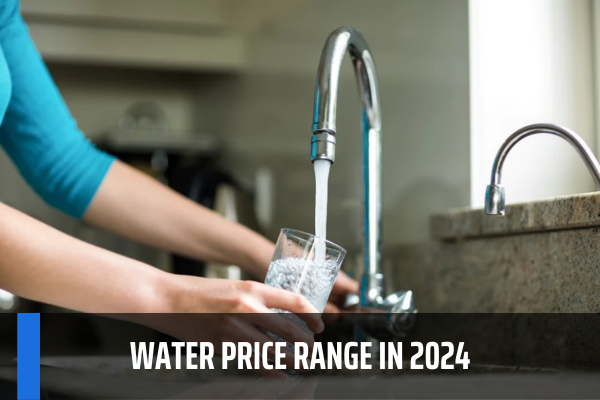What is the tap water price range in 2024? What are the principles for calculation of water prices in Vietnam?
What is the tap water price range in Vietnam?
Pursuant to the provisions of Article 54 of Decree 117/2007/ND-CP, on clean water production, supply and consumption.
Specifically, based on Clause 1, Article 3 of Circular 44/2021/TT-BTC, the tap water price range is shown as follows:
No. | Classification | Minimum price (VND/m3) | Maximum price (VND/m3) |
1 | Special, grade-1 cities | 3,500 | 18,000 |
2 | Grade-2, grade-3, grade-4 and grade-5 cities | 3,000 | 15,000 |
3 | Rural areas | 2,000 | 11,000 |
(The aforesaid price range is inclusive of the value-added tax and is applied to the average tap water selling prices decided by provincial People's Committees.)
Particularly for each locality, domestic water prices will be approved and issued by the Provincial People's Committee, in accordance with the price range issued by the Minister of Finance.
Annually, tap water suppliers shall actively assess the implementation of tap water price plans and review tap water prices in the subsequent year. If there is any fluctuation in production and trading cost factors that results in any increase or decrease in the subsequent-year tap water prices, tap water suppliers shall prepare the tap water price plan dossier for submission to Departments of Finance in order for them to review them before being presented to provincial People’s Committees to seek their decision on approval of appropriate adjustments. After completing the evaluation process, if a tap water supplier expects that the production cost per 01 m3 of tap water in the coming year would be increased to the one it can financially balance out, it shall submit a written request for the stabilization of tap water price to the Department of Finance that then reports on such request to the provincial People’s Committee (for its information only).
For example in Ho Chi Minh City:
Based on Article 1 of Decision 25/2019/QD-UBND, regulations on tap water prices in Ho Chi Minh City in the period 2019 - 2022 are as follows:

(The aforesaid price range is inclusive of the value-added tax)
Accordingly, the price of tap water for daily use in the HCMC until 2022 as follows:
(1) For residential households:
- Water usage norm from 0 to 4m3/person/month: 6,700 VND/m3
- Water usage norm from 4m3 to 6m3/person/month: 12,900 VND/m3
- Water usage norm over 6m3/person/month: 14,400 VND/m3
(2) For poor and near-poor households:
- Water usage norm from 0 to 4m3/person/month: 6,300 VND/m3
- Water usage norm from 4m3 to 6m3/person/month: 12,900 VND/m3
- Water usage norm over 6m3/person/month: 14,400 VND/m3
Currently, there is no change in tap water prices in the HCMC. Therefore, the price of tap water in HCMC still applies the 2022 tap water price mentioned above.

What is the tap water price range in 2024? What are the principles for calculation of water prices in Vietnam? (Image from the Internet)
What are the principles for calculation of water prices in Vietnam?
Pursuant to the provisions of Article 51 of Decree 117/2007/ND-CP amended by Clause 10, Article 1 of Decree 124/2011/ND-CP as follows:
The principles for calculation of water prices
1. Clean water prices must be calculated accurately and fully the rational cost factors of production in the process of production and distribution of clean water (including the cost of maintaining connections) to ensure the legitimate rights and interests of units of water supply and water-users.
2. Ensuring the rights to self-decision on water purchase and sale prices within the price brackets set by the State.
3. Clean water prices must ensure that water supply units can maintain, develop and raise the quality of services and contribute to the thrifty use of water, taking into account support for the poor.
4. Clean water prices are determined in suitability to water sources, water production conditions of each region, each locality, each zone.
5. Clean water prices are determined regardless of users being domestic or foreign organizations or individuals.
6. Implementing the mechanism of reasonable price subsidies between groups of customers with different use purposes, gradually reducing and proceeding to eliminate the cross-subsidy between prices of water used for daily-life activities and prices of water used for other purposes, contributing to boosting production and increasing the competitiveness of water supply units.
7. Local administrations at all levels, organizations and individuals engaged in water supply activities must work out programs against the loss of water and water charges, adopt contracting and rewarding mechanisms while setting the maximum levels of water and water charge loss eligible for inclusion into production costs so as to encourage water supply units to operate with efficiency.
8. If the decided clean water prices are lower than the accurately and fully calculated prices of clean water, provincial-level Peoples Committees shall annually consider and allocate the deficit amounts from local budgets in order to ensure the lawful rights and interests of water supply units.
9. The Finance Ministry shall assume the prime responsibility for, and coordinate with the Construction Ministry and the Ministry of Agriculture and Rural Development in, guiding the principles and methods of determining clean water consumption prices.
Thus, currently, water prices are calculated according to the above principles.
What are the bases of the establishment and adjustment of water prices in Vietnam?
Pursuant to the provisions of Article 52 of Decree 117/2007/ND-CP supplemented by Clause 11, Article 1 of Decree 124/2011/ND-CP.
Bases of the establishment and adjustment of water prices
- The principles for water price calculation.
- The socio-economic development conditions of the country and regions and peoples incomes in each period.
- The clean water supply-demand relationship.
- Clean water production and business costs and reasonal profits of water-supply units.
- The changes in water-treating technology, service quality standards, fluctuations in market prices and state policies.
- As scheduled price adjustment approved by the provincial People's Committees.
LawNet